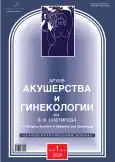Minihysteroresectoscopy for optimizing transcervical methods for treating intrauterine pathologies
- Authors: Kharitonenko P.S.1, Fedorov A.A.1, Bespalova A.G.1, Turina S.S.1, Sopova Y.I.1, Popov A.A.1
-
Affiliations:
- Moscow Regional Research Institute of Obstetrics and Gynecology named after Academician V.I. Krasnopolsky
- Issue: Vol 11, No 1 (2024)
- Pages: 41-48
- Section: Literature reviews
- URL: https://journal-vniispk.ru/2313-8726/article/view/255367
- DOI: https://doi.org/10.17816/2313-8726-2024-11-1-41-48
- ID: 255367
Cite item
Abstract
The uterine factor ranks third among the causes of infertility, accounting for 10–15% and increasing to 50% when combined with other factors. Currently, the introduction of new technologies into medical practice allows the doctor to choose various methods of surgical treatment of intrauterine pathology [endometrial polyp, uterine fibroids with a submucosal location of the G0–G1 node (International Federation of Gynecology and Obstetrics, FIGO), intrauterine adhesions, and congenital malformations of the uterus], including those without anesthetic support. Modern innovations in hysteroscopic surgery have radically changed the way intrauterine pathologies are treated, thanks to the emergence of the “see-and-treat” philosophy and the universal trend toward the miniaturization of office surgical tools and high-resolution optical systems without compromising their functional characteristics. However, many aspects of hysteroresectoscopy in an outpatient setting, namely, its optimal range of applications, advantages and disadvantages in diagnostics and treatment of intrauterine pathologies, and economic components, are not sufficiently covered. This literature review discussed the most current data on the technique and possibilities of using a mini-hysteroresectoscope in outpatient surgical hysteroscopy.
Full Text
##article.viewOnOriginalSite##About the authors
Polina S. Kharitonenko
Moscow Regional Research Institute of Obstetrics and Gynecology named after Academician V.I. Krasnopolsky
Author for correspondence.
Email: shilkina_p@mail.ru
ORCID iD: 0000-0002-3922-5085
postgraduate student, obstetrician-gynecologist
Russian Federation, MoscowAnton A. Fedorov
Moscow Regional Research Institute of Obstetrics and Gynecology named after Academician V.I. Krasnopolsky
Email: aa.fedorov@mail.ru
ORCID iD: 0000-0003-2590-5087
MD, Dr. Sci. (Medicine)
Russian Federation, MoscowAnastasia G. Bespalova
Moscow Regional Research Institute of Obstetrics and Gynecology named after Academician V.I. Krasnopolsky
Email: bespalowa.nast@yandex.ru
ORCID iD: 0000-0003-1940-9001
obstetrician-gynecologist
Russian Federation, MoscowSvetlana S. Turina
Moscow Regional Research Institute of Obstetrics and Gynecology named after Academician V.I. Krasnopolsky
Email: dr_tyurina@mail.ru
ORCID iD: 0000-0002-7898-2724
канд. мед. наук
Russian Federation, MoscowYulia I. Sopova
Moscow Regional Research Institute of Obstetrics and Gynecology named after Academician V.I. Krasnopolsky
Email: rakova_yuliya@mail.ru
MD, Cand. Sci. (Medicine)
Russian Federation, MoscowAlexander A. Popov
Moscow Regional Research Institute of Obstetrics and Gynecology named after Academician V.I. Krasnopolsky
Email: gyn_endoscopy@mail.ru
ORCID iD: 0000-0003-3692-2421
MD, Dr. Sci. (Medicine), Head of the Department
Russian Federation, MoscowReferences
- Hur C, Rehmer J, Flyckt R, Falcone T. Uterine Factor Infertility: A Clinical Review. Clin Obstet Gynecol. 2019;62(2):257–270. doi: 10.1097/GRF.0000000000000448
- Sallée C, Margueritte F, Marquet P, et al. Uterine Factor Infertility, a Systematic Review. J Clin Med. 2022;11(16):4907. doi: 10.3390/jcm11164907
- Brännström M, Johannesson L, Dahm-Kähler P, et al. First clinical uterus transplantation trial: A six-month report. Fertil Steril. 2014;101(5):1228–1236. doi: 10.1016/j.fertnstert.2014.02.024
- Popov AA, Machansckite OV, Golovina EN. Office Hysteroscopy and Infertility. Journal of Obstetrics and Women’s Diseases. 2011;LX(4):87–90.
- Brown SE, Coddington CC, Schnorr J, et al. Evaluation of outpatient hysteroscopy, saline infusion hysterosonography, and hysterosalpingography in infertile women: a prospective, randomized study. Fertil Steril. 2000;74(5):1029–1034. doi: 10.1016/s0015-0282(00)01541-7
- Chupin AN, Mamyrbekova SA, Aldangarova GA. Evaluation of the effectiveness of the use of a bipolar mini-resectoscope to improve the provision of gynecological care to patients with intrauterine pathology. Bulletin of Surgery in Kazakhstan. 2021;(1):31–35.
- Practice Committee of the American Society for Reproductive Medicine. Removal of myomas in asymptomatic patients to improve fertility and/or reduce miscarriage rate: a guideline. Fertil Steril. 2017;108(3):416–425. doi: 10.1016/j.fertnstert.2017.06.034
- Papalampros P, Gambadauro P, Papadopoulos N, et al. The mini-resectoscope: a new instrument for office hysteroscopic surgery. Acta Obstet Gynecol Scand. 2009;88(2):227–230. doi: 10.1080/00016340802516585
- Klyucharov IV, Makarenko TA, Galkina DE, Popov AA, Bespalova AG. Complications of hysteroscopy and hysteroresectoscopy: diagnosis, treatment, prevention. Russian Bulletin of Obstetrician-Gynecologist. 2022;22(1):5865. doi: 10.17116/rosakush20222201158
- Munro MG, Christianson LA. Complications of hysteroscopic and uterine resectoscopic surgery. Clin Obstet Gynecol. 2015;58(4):765–797. doi: 10.1097/GRF.0000000000000146
- McGuran PM, Mcllwaine P. Complications of hysteroscopy and how to avoid them. Best Pract Res Clin Obstet Gynaecol. 2015;29(7):982–993. doi: 10.1016/j.bpobgyn.2015.03.009
- Mazo VC. Fibroids and Hysteroscopy: An Overview. In: Abduljabbar H, editor. Fibroids. 2020. doi: 10.5772/intechopen.94102
- Dealberti D, Riboni F, Cosma S, et al. Feasibility and Acceptability of Office-Based Polypectomy With a 16F Mini-Resectoscope: A Multicenter Clinical Study. J Minim Invasive Gynecol. 2016;23(3):418–424. doi: 10.1016/j.jmig.2015.12.016
- Wortman M. “See-and-Treat” Hysteroscopy in the Management of Endometrial Polyps. Surg Technol Int. 2016;28:177–184.
- Garuti G, Luerti M. Hysteroscopic bipolar surgery: a valuable progress or a technique under investigation? Curr Opin Obstet Gynecol. 2009;21(4):329–334. doi: 10.1097/GCO.0b013e32832e07ac
- Vitale SG, Haimovich S, Riemma G, et al. Innovations in hysteroscopic surgery: expanding the meaning of “in-office”. Minim Invasive Ther Allied Technol. 2021;30(3):125–132. doi: 10.1080/13645706.2020.1715437
- Campo V, Campo S. Hysteroscopy requirements and complications. Minerva Ginecol. 2007;59(4):451–457.
- Connor M. New technologies and innovations in hysteroscopy. Best Pract Res Clin Obstet Gynaecol. 2015;29(7):951–965. doi: 10.1016/j.bpobgyn.2015.03.012
- Centini G, Troia L, Lazzeri L, Petraglia F, Luisi S. Modern operative hysteroscopy. Minerva Ginecol. 2016;68(2):126–132.
- Biela MM, Doniec J, Kamiński P. Too big? A review of methods for removing large endometrial polyps in office minihysteroscopy ― broadening the indications for the procedure in the COVID-19 pandemic. Wideochir Inne Tech Maloinwazyjne. 2022;17(1):104–109. doi: 10.5114/wiitm.2021.107762
- Bettocchi S, Nappi L, Ceci O, Selvaggi L. Office hysteroscopy. Obstet Gynecol Clin North Am. 2004;31(3):641–654, xi. doi: 10.1016/j.ogc.2004.05.007
- Roy KK, Anusha SM, Rai R, et al. Prospective Randomized Comparative Clinical trial of Hysteroscopic Septal Resection Using Conventional Resectoscope Versus Mini-resectoscope. J Hum Reprod Sci. 2021;14(1):61–67. doi: 10.4103/jhrs.JHRS_12_20
- Casadio P, Gubbini G, Franchini M, et al. Comparison of Hysteroscopic Cesarean Scar Defect Repair with 26 Fr Resectoscope and 16 Fr Mini-resectoscope: A Prospective Pilot Study. J Minim Invasive Gynecol. 2021;28(2):314–319. doi: 10.1016/j.jmig.2020.06.002
Supplementary files










